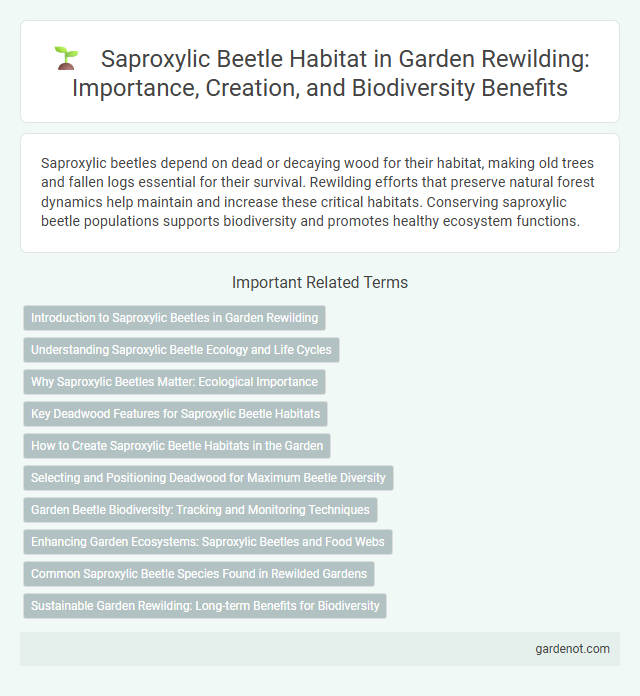Saproxylic beetles depend on dead or decaying wood for their habitat, making old trees and fallen logs essential for their survival. Rewilding efforts that preserve natural forest dynamics help maintain and increase these critical habitats. Conserving saproxylic beetle populations supports biodiversity and promotes healthy ecosystem functions.
Introduction to Saproxylic Beetles in Garden Rewilding
Saproxylic beetles play a critical role in garden rewilding by decomposing dead wood and enriching soil biodiversity. Their habitat depends on fallen branches, decaying trunks, and old tree stumps, which provide essential microhabitats for larval development. Promoting deadwood retention within gardens supports saproxylic beetle populations and enhances ecosystem resilience.
Understanding Saproxylic Beetle Ecology and Life Cycles
Saproxylic beetle ecology centers on their dependence on dead or decaying wood, which provides critical habitat for feeding and reproduction. Their life cycles involve larval stages developing within various types of decaying wood, influencing nutrient cycling and forest health. Understanding these beetles' specificity to wood decay stages and microhabitats aids in designing effective rewilding projects that promote biodiversity and ecosystem restoration.
Why Saproxylic Beetles Matter: Ecological Importance
Saproxylic beetles play a crucial role in forest ecosystems by decomposing dead wood, which recycles nutrients and maintains soil fertility. Their presence supports biodiversity by providing food for birds, mammals, and other insects, creating a balanced habitat. Protecting saproxylic beetle habitats is essential for sustaining natural forest regeneration and ecosystem resilience in rewilding projects.
Key Deadwood Features for Saproxylic Beetle Habitats
Key deadwood features essential for saproxylic beetle habitats include the presence of veteran trees with varying degrees of decay and hollows that provide shelter and breeding sites. The diversity of wood types, sizes, and stages of decomposition enhances microhabitat complexity, supporting specialized beetle species. Retaining large fallen logs and standing deadwood ensures continuous availability of nutritional resources critical for the saproxylic beetle lifecycle.
How to Create Saproxylic Beetle Habitats in the Garden
Creating saproxylic beetle habitats in the garden involves preserving deadwood and decaying trees, which are essential for their life cycle. Incorporate logs, stumps, and fallen branches in shaded, moist areas to mimic natural forest conditions that support fungal growth and larvae development. Avoid removing old wood during garden cleanups to maintain a stable microhabitat for diverse saproxylic beetle species.
Selecting and Positioning Deadwood for Maximum Beetle Diversity
Selecting deadwood with varying decay stages, sizes, and tree species enhances habitat complexity crucial for saproxylic beetle diversity. Positioning logs both sun-exposed and shaded creates microhabitats that support different beetle assemblages and life cycles. Integrating standing dead trees (snags) alongside fallen wood increases structural heterogeneity, promoting long-term beetle species richness in rewilded forests.
Garden Beetle Biodiversity: Tracking and Monitoring Techniques
Saproxylic beetle habitats are vital for maintaining garden beetle biodiversity, relying on deadwood and decaying plant matter for survival and reproduction. Effective tracking and monitoring techniques include pitfall traps, emergence traps, and DNA metabarcoding, which provide critical data on species diversity and population dynamics. Utilizing geospatial analysis and long-term ecological surveys enhances understanding of habitat connectivity and supports targeted conservation strategies.
Enhancing Garden Ecosystems: Saproxylic Beetles and Food Webs
Saproxylic beetle habitats enhance garden ecosystems by supporting nutrient cycling and promoting biodiversity through their role in decomposing dead wood. These beetles provide crucial food sources for birds, mammals, and other invertebrates, strengthening local food webs. Preserving fallen branches and maintaining diverse plant species ensures a thriving environment for saproxylic beetles and overall ecological resilience.
Common Saproxylic Beetle Species Found in Rewilded Gardens
Common saproxylic beetle species found in rewilded gardens include the Violet Click Beetle (Limoniscus violaceus), the Horned Powder-Blue Beetle (Bolitophagus reticulatus), and the Hazelwood Sap Beetle (Nacerdes carniolica). These beetles depend on decaying wood from native hardwoods like oak, ash, and beech, which are abundant in rewilded environments. Maintaining deadwood in various stages of decomposition provides critical habitat for their life cycles and supports broader biodiversity in rewilded garden ecosystems.
Sustainable Garden Rewilding: Long-term Benefits for Biodiversity
Saproxylic beetle habitats thrive in sustainable garden rewilding by preserving deadwood and native vegetation, essential for their life cycles and ecological functions. Long-term benefits include enhanced biodiversity, improved soil health, and natural pest control, fostering resilient ecosystems within garden spaces. Rewilding practices create interconnected habitats that support saproxylic beetles and other species, promoting ecological balance and sustainability.
Saproxylic beetle habitat Infographic

 gardenot.com
gardenot.com